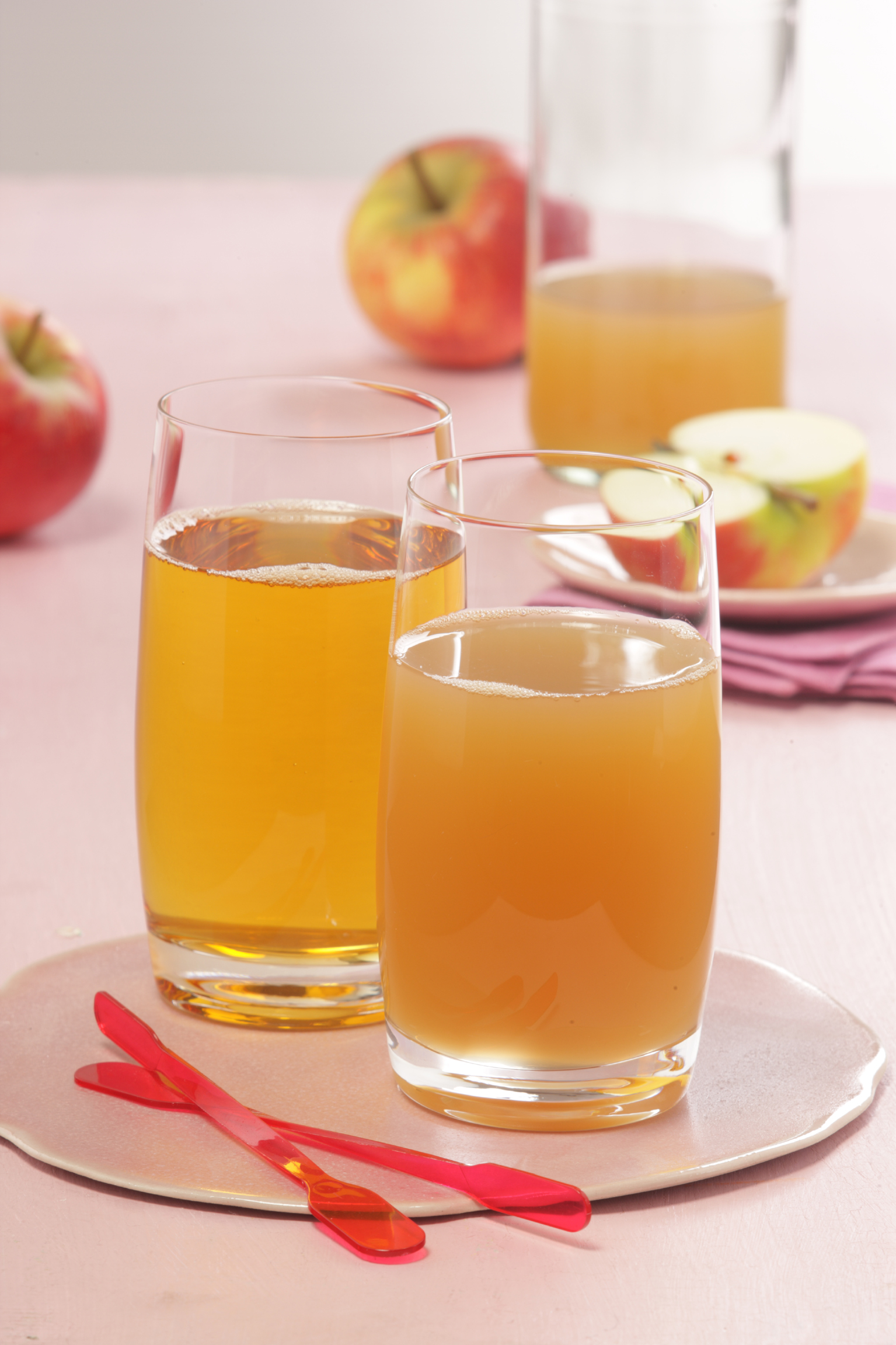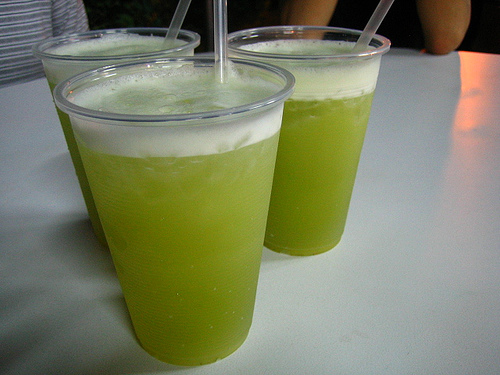|
Apple Juice
Apple juice is a fruit juice made by the maceration and pressing of an apple. The resulting expelled juice may be further treated by enzymatic and centrifugal clarification to remove the starch and pectin, which holds fine particulate in suspension, and then pasteurized for packaging in glass, metal, or aseptic processing system containers, or further treated by dehydration processes to a concentrate. Due to the complex and costly equipment required to extract and clarify juice from apples in large volume, apple juice is normally produced commercially. In the United States, unfiltered fresh apple juice is made by smaller operations in areas of high apple production, in the form of unclarified apple cider. Apple juice is one of the most common fruit juices globally, with world production led by China, Poland, the United States, and Germany. Production Apples used for apple juice are usually harvested between September and mid-November in the Northern Hemisphere and between Feb ... [...More Info...] [...Related Items...] OR: [Wikipedia] [Google] [Baidu] |
Log Reduction
Log reduction is a measure of how thoroughly a decontamination process reduces the concentration of a contaminant. It is defined as the common logarithm of the ratio of the levels of contamination before and after the process, so an increment of 1 corresponds to a reduction in concentration by a factor of 10. In general, an -log reduction means that the concentration of remaining contaminants is only times that of the original. So for example, a 0-log reduction is no reduction at all, while a 1-log reduction corresponds to a reduction of 90 percent from the original concentration, and a 2-log reduction corresponds to a reduction of 99 percent from the original concentration. Mathematical definition Let and be the numerical values of the concentrations of a given contaminant, respectively before and after treatment, following a defined process. It is irrelevant in what units these concentrations are given, provided that both use the same units. Then an and -log reduction is achie ... [...More Info...] [...Related Items...] OR: [Wikipedia] [Google] [Baidu] |
List Of Juices
This is a list of juices. Juice is a liquid that is naturally contained in fruit and vegetables. It can also refer to liquids that are flavored with these or other biological food sources such as meat and seafood. It is commonly consumed as a beverage or used as an ingredient or flavoring in foods. Juices See also * Fruit and vegetable beer * Health shake * Juice bar ** Mexican juice bar (''frutería'') * Juicer * Juicing * List of fruit dishes * List of lemonade topics * List of lemon dishes and beverages * List of vegetable dishes This is a list of vegetable dishes, that includes dishes in which the main ingredient or one of the essential ingredients is a vegetable or vegetables. In culinary terms, a vegetable is an edible plant or its part, intended for cooking or eating ... References {{DEFAULTSORT:Juices, List Of * * * Lists of drinks ... [...More Info...] [...Related Items...] OR: [Wikipedia] [Google] [Baidu] |
Juicing
Juicing is the process of extracting juice from plant tissues such as fruit or vegetables. Overview There are many methods of juicing, from squeezing fruit by hand to wide-scale extraction with industrial equipment. Juicing is generally the preferred method of consuming large amounts of produce quickly and is often completed with a household appliance called a juicer, which may be as simple as a cone upon which fruit is mashed or as sophisticated as a variable-speed, motor-driven device. It may also refer to the act of extracting and then drinking juice or those who extract the juice. Juicing is different from buying juice in the supermarket because it focuses on fresh pressed fruits and vegetables. Residential juicing is often practiced for dietary reasons or as a form of alternative medicine. Becoming first popular in the early 1970s, interest in juicing has since increased. Films such as ''Fat, Sick and Nearly Dead'', ''Food Matters'', and '' Hungry for Change'' have inc ... [...More Info...] [...Related Items...] OR: [Wikipedia] [Google] [Baidu] |
Cider
Cider ( ) is an alcoholic beverage made from the fermented juice of apples. Cider is widely available in the United Kingdom (particularly in the West Country) and the Republic of Ireland. The UK has the world's highest per capita consumption, as well as the largest cider-producing companies. Ciders from the South West of England are generally higher in alcoholic content. Cider is also popular in many Commonwealth countries, such as India, Canada, Australia, and New Zealand. As well as the UK and its former colonies, cider is popular in Portugal (mainly in Minho and Madeira), France (particularly Normandy and Brittany), Friuli, and northern Spain (specifically Asturias). Central Europe also has its own types of cider with Rhineland-Palatinate and Hesse producing a particularly tart version known as Apfelwein. In the U.S., varieties of fermented cider are often called ''hard cider'' to distinguish alcoholic cider from non-alcoholic apple cider or "sweet cider", also made from ... [...More Info...] [...Related Items...] OR: [Wikipedia] [Google] [Baidu] |
Canning
Canning is a method of food preservation in which food is processed and sealed in an airtight container (jars like Mason jars, and steel and tin cans). Canning provides a shelf life that typically ranges from one to five years, although under specific circumstances, it can be much longer. A freeze-dried canned product, such as canned dried lentils, could last as long as 30 years in an edible state. In 1974, samples of canned food from the wreck of the ''Bertrand'', a steamboat that sank in the Missouri River in 1865, were tested by the National Food Processors Association. Although appearance, smell, and vitamin content had deteriorated, there was no trace of microbial growth and the 109-year-old food was determined to be still safe to eat. History and development French origins During the first years of the Napoleonic Wars, the French government offered a hefty cash award of 12,000 francs to any inventor who could devise a cheap and effective method of preserving l ... [...More Info...] [...Related Items...] OR: [Wikipedia] [Google] [Baidu] |
Micronutrient
Micronutrients are nutrient, essential dietary elements required by organisms in varying quantities throughout life to orchestrate a range of physiological functions to maintain health. Micronutrient requirements differ between organisms; for example, humans and other animals require numerous vitamins and Mineral (nutrient), dietary minerals, whereas plants require specific minerals. For human nutrition, micronutrient requirements are in amounts generally less than 100 milligrams per day, whereas nutrient, macronutrients are required in gram quantities daily. The minerals for humans and other animals include 13 elements that originate from Earth's soil and are not synthesized by living organisms, such as calcium and iron. Micronutrient requirements for animals also include vitamins, which are organic compounds required in microgram or milligram amounts. Since plants are the primary origin of nutrients for humans and animals, some micronutrients may be in low levels and deficiencies ... [...More Info...] [...Related Items...] OR: [Wikipedia] [Google] [Baidu] |
Calorie
The calorie is a unit of energy. For historical reasons, two main definitions of "calorie" are in wide use. The large calorie, food calorie, or kilogram calorie was originally defined as the amount of heat needed to raise the temperature of one kilogram of water by one degree Celsius (or one kelvin). The small calorie or gram calorie was defined as the amount of heat needed to cause the same increase in one gram of water. Thus, 1 large calorie is equal to 1000 small calories. In nutrition and food science, the term ''calorie'' and the symbol ''cal'' almost always refers to the large unit. It is generally used in publications and package labels to express the energy value of foods in per serving or per weight, recommended dietary caloric intake, metabolic rates, etc. Some authors recommend the spelling ''Calorie'' and the symbol ''Cal'' (both with a capital C) to avoid confusion; however, this convention is often ignored. In physics and chemistry the word ''calorie'' and i ... [...More Info...] [...Related Items...] OR: [Wikipedia] [Google] [Baidu] |
Protein
Proteins are large biomolecules and macromolecules that comprise one or more long chains of amino acid residues. Proteins perform a vast array of functions within organisms, including catalysing metabolic reactions, DNA replication, responding to stimuli, providing structure to cells and organisms, and transporting molecules from one location to another. Proteins differ from one another primarily in their sequence of amino acids, which is dictated by the nucleotide sequence of their genes, and which usually results in protein folding into a specific 3D structure that determines its activity. A linear chain of amino acid residues is called a polypeptide. A protein contains at least one long polypeptide. Short polypeptides, containing less than 20–30 residues, are rarely considered to be proteins and are commonly called peptides. The individual amino acid residues are bonded together by peptide bonds and adjacent amino acid residues. The sequence of amino acid residue ... [...More Info...] [...Related Items...] OR: [Wikipedia] [Google] [Baidu] |
Carbohydrate
In organic chemistry, a carbohydrate () is a biomolecule consisting of carbon (C), hydrogen (H) and oxygen (O) atoms, usually with a hydrogen–oxygen atom ratio of 2:1 (as in water) and thus with the empirical formula (where ''m'' may or may not be different from ''n''), which does not mean the H has covalent bonds with O (for example with , H has a covalent bond with C but not with O). However, not all carbohydrates conform to this precise stoichiometric definition (e.g., uronic acids, deoxy-sugars such as fucose), nor are all chemicals that do conform to this definition automatically classified as carbohydrates (e.g. formaldehyde and acetic acid). The term is most common in biochemistry, where it is a synonym of saccharide (), a group that includes sugars, starch, and cellulose. The saccharides are divided into four chemical groups: monosaccharides, disaccharides, oligosaccharides, and polysaccharides. Monosaccharides and disaccharides, the smallest (lower molecular wei ... [...More Info...] [...Related Items...] OR: [Wikipedia] [Google] [Baidu] |
Hepatitis A
Hepatitis A is an infectious disease of the liver caused by ''Hepatovirus A'' (HAV); it is a type of viral hepatitis. Many cases have few or no symptoms, especially in the young. The time between infection and symptoms, in those who develop them, is 2–6 weeks. When symptoms occur, they typically last 8 weeks and may include nausea, vomiting, diarrhea, jaundice, fever, and abdominal pain. Around 10–15% of people experience a recurrence of symptoms during the 6 months after the initial infection. Acute liver failure may rarely occur, with this being more common in the elderly. It is usually spread by eating food or drinking water contaminated with infected feces. Undercooked or raw shellfish are relatively common sources. It may also be spread through close contact with an infectious person. While children often do not have symptoms when infected, they are still able to infect others. After a single infection, a person is immune for the rest of his or her life. Diagnosis requir ... [...More Info...] [...Related Items...] OR: [Wikipedia] [Google] [Baidu] |
Clostridium Botulinum
''Clostridium botulinum'' is a Gram-positive, rod-shaped, anaerobic, spore-forming, motile bacterium with the ability to produce the neurotoxin botulinum. The botulinum toxin can cause botulism, a severe flaccid paralytic disease in humans and other animals, and is the most potent toxin known to mankind, natural or synthetic, with a lethal dose of 1.3–2.1 ng/kg in humans.(2010). Chapter 19. ''Clostridium'', ''Peptostreptococcus'', ''Bacteroides'', and Other Anaerobes. In Ryan K.J., Ray C (Eds), ''Sherris Medical Microbiology'', 5th ed. ''C. botulinum'' is a diverse group of pathogenic bacteria initially grouped together by their ability to produce botulinum toxin and now known as four distinct groups, ''C. botulinum'' groups I–IV, as well as some strains of ''Clostridium butyricum'' and ''Clostridium baratii'', are the bacteria responsible for producing botulinum toxin. ''C. botulinum'' is responsible for foodborne botulism (ingestion of preformed toxin), infant bot ... [...More Info...] [...Related Items...] OR: [Wikipedia] [Google] [Baidu] |






